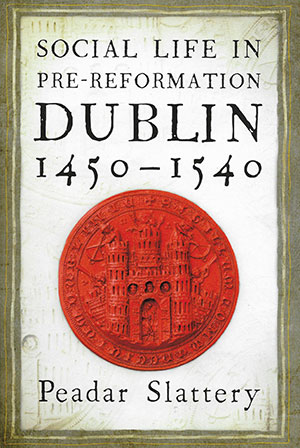SOCIAL LIFE IN PRE-REFORMATION DUBLIN, 1450–1540
Published in Book Reviews, Book Reviews, Issue 6 (November/December 2019)PEADAR SLATTERY
Four Courts Press
€45
ISBN 9781846 827907
Reviewed by Henry A. Jefferies
Henry A. Jefferies is a Research Associate in History at Ulster University.
 This is a rare book, an academic study that will certainly appeal to a popular readership. In remarkable detail, Dr Slattery describes what life was actually like for the people of Dublin in the final decades of the later Middle Ages. He has mined Dublin’s voluminous records with impressive care, made excellent use of a tremendous number of specialist studies on aspects of Dublin’s past—with the Four Courts Press Medieval Dublin series, edited by Seán Duffy, deservedly being acknowledged in particular—and integrates into his book the fruits of work done on mapping medieval Dublin by Howard Clarke and others. Slattery’s text is illustrated with several maps among its 31 figures. It has fourteen colour plates, mostly of items that will be new to readers, and fifteen tables.
This is a rare book, an academic study that will certainly appeal to a popular readership. In remarkable detail, Dr Slattery describes what life was actually like for the people of Dublin in the final decades of the later Middle Ages. He has mined Dublin’s voluminous records with impressive care, made excellent use of a tremendous number of specialist studies on aspects of Dublin’s past—with the Four Courts Press Medieval Dublin series, edited by Seán Duffy, deservedly being acknowledged in particular—and integrates into his book the fruits of work done on mapping medieval Dublin by Howard Clarke and others. Slattery’s text is illustrated with several maps among its 31 figures. It has fourteen colour plates, mostly of items that will be new to readers, and fifteen tables.
The book looks at how Dublin was governed by its mayor and 24 jurés, ‘the effective council in the ruling of the city’. The council had several major responsibilities, the defence of the city against Irish or rebel English attacks being a top priority. Dublin was a colonial outpost and its (mostly but not exclusively) English citizens worried constantly about the state of the city’s walls and gates, although they were not enthusiastic about paying more tax to maintain them. Slattery explains how the night-watch was organised in Dublin and presents a very helpful map of the routes taken by the night-watchmen. He also explains how Dublin’s water supply was organised. There was a reservoir located in the vicinity of St James’ Gate and a watercourse made up of a section of the Poddle and two artificial channels fed by water from Balrothery weir on the Dodder, ‘a brilliant piece of engineering’, which ‘led to the delivery of about 2.73 million litres (600,000 gallons) of water daily to the city’. The council ensured that the inhabitants, numbering about 6,000–8,000 in the middle of the fifteenth century, did not starve, and it regulated the quality and quantity of food in the city. The problems posed by refuse, not least the disposal of human excrement, animal dung and animal by-products discarded by butchers and tanners, were of tremendous concern to (most of) the citizens of Dublin. Pigs and cows wandering around the streets added very considerably to the problem and constituted a real menace to life and limb. The city council struggled to manage the filth and to reduce the ‘pestilential exhalations’ that hung over the city, but towards the end of the fifteenth century the problems seem to have grown worse rather than better.
Dublin’s economic bases were formed by trade and manufacturing, and Slattery analyses Dublin’s commerce, shipping, Irish Sea trade and trade with its hinterland in fascinating detail. He discusses the merchants at the heart of this commerce, and their interrelationships. There is a survey of manufacturing in the city, and a very fine study of Dublin’s guilds and the relationships between guild masters and their apprentices, who were almost invariably men. Yet Slattery reveals that in the Dublin city franchise roll for 1468–1512 there are records of 71 women who completed apprenticeships—with a merchant, armourer, butcher, clerk, cook, corviser, glover, justice, painter, smith, tanner or vintner—leading to the granting of citizenship. There are occasional references, too, to women working on ships as a merchant’s agent. Clearly it was possible for women to circumvent what would now be termed ‘gender barriers’ if they had the desire and the ability to do so.
There is a sizeable chapter on ‘The traditional church’, and another on ‘A changing growing church’. A lot of the references underpinning them are to studies of the church in England. It is surprising that they did not set the church in Dublin in the wider context of recent work done on the Irish church, which showed that it was in surprisingly good order over much of Ireland, but especially in the Pale, and was experiencing a remarkable revival in its fortunes until Henry VIII divorced his first wife. Even so, Slattery succeeds in showing that the late medieval church in Dublin was very vibrant and popular and met its people’s expectations. There is a very interesting chapter on dramatic presentations in Dublin, which deals mainly with the religious plays and civic pageants that were so integral a part of life in late medieval Dublin.
The book finishes with a chapter highlighting continuities and changes in Dublin up to 1540. The economic material might have been better discussed in previous chapters, while much of the religious material is already familiar. The epilogue could have linked this book with Colm Lennon’s outstanding work on The lords of Dublin from 1547. Nonetheless, this is an impressive book by any standards. Dr Slattery has transformed our understanding of late medieval Dublin and its inhabitants in a most readable manner.
















